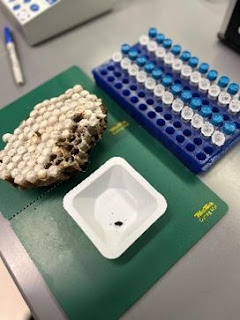Telissa Wilson
WSDA Plant Pathology and Molecular Diagnostics Lab
 |
| Northern giant hornets in vials awaiting testing. |
Like a forensic lab, PPMDL maintains highly trained staff, follows strict quality control measures, contributes to research and development of detection tools, and often collaborates with a wide array of organizations. Below is a snapshot of some recent work that showcases PPMDL projects straight out of a CSI episode.
Haplotyping invasive weeds
Sometimes it can be difficult to differentiate between species - whether it is a weedy plant or an invasive insect. Is this species a crime suspect or victim? Haplotyping compares genetic information among different samples to better understand how closely the samples are related - whether it is a native species or a wolf in sheep's clothing.
Enter suspect number 1: the highly invasive, aquatic grass Phragmites australis. Because the different subspecies of Phragmites grass are so difficult to tell apart visually, their haplotypes are used to assign them a native or non-native status, which is needed to guide treatment plans.
For this work, PPMDL staff first extract DNA from submitted leaf samples. Then staff use a process called Polymerase Chain Reaction (PCR) to copy the DNA of very specific regions- regions that have been empirically determined to be good markers for haplotyping in a given species. The last step requires sequencing of the resulting PCR product so the sample haplotypes can be compared against a database of known haplotypes. In the case of Phragmites australis, haplotyping has allowed wetland managers across multiple agencies to preserve their native grass stands and only destroy the invaders. In our CSI analogy, you could say that haplotyping ensures that only the true perpetrator - Phragmites australis – does time for the crime.
Forensic swabbing for trace DNA
 |
| Forensic swabbing can detect where a pest has been. |
You have probably seen shows where crime scenes are swabbed for the presence of DNA left behind on surfaces. These swabs are then shipped to a forensic lab, where scientists extract DNA and perform various molecular tests to analyze the sample. Even though forensic scientists have been utilizing trace DNA for decades to confirm presence at a crime scene, using trace DNA to detect agricultural pests is in its infancy.
eDNA
Our pathology lab is changing that. PPMDL has been using swabs to collect environmental DNA (eDNA) left behind by two invasive insects – the spotted lantern fly (SLF) and the northern giant hornet (NGH). Once validated, these assays can confirm the presence of SLF and NGH at sites where a physical sample cannot be collected and early on before pest density is high enough to use alternative survey methods.
Pathogen detection
 |
| An exponential curve corresponds to positive detection in a qPCR test |
DNA analysis of fecal samples
 |
| PPMDL conducts fecal analysis to determine hornets' diet |
What did we find? Well, many folks have heard that northern giant hornets are a major threat to honey bees, but many other pollinators were also on their menu. PPMDL also found that bald-faced hornets made up a majority of the sequences obtained across all nests. Check out this "Wings menu" our Communications folks put together showing some of what they were eating.

.png)